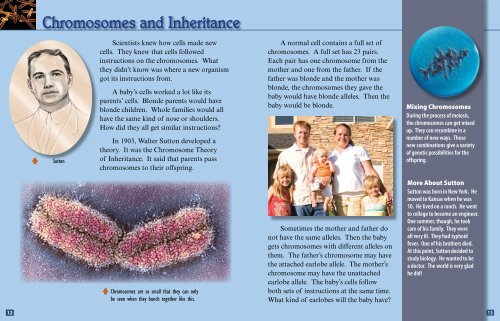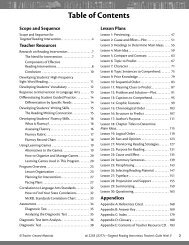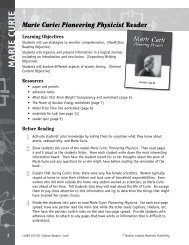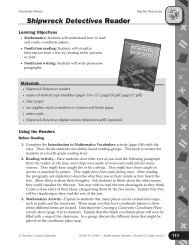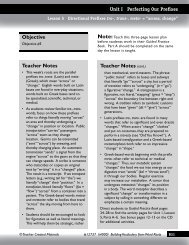Sample Pages - Teacher Created Materials
Sample Pages - Teacher Created Materials
Sample Pages - Teacher Created Materials
You also want an ePaper? Increase the reach of your titles
YUMPU automatically turns print PDFs into web optimized ePapers that Google loves.
Chromosomes and Inheritance<br />
Sutton<br />
Scientists knew how cells made new<br />
cells. They knew that cells followed<br />
instructions on the chromosomes. What<br />
they didn’t know was where a new organism<br />
got its instructions from.<br />
A baby’s cells worked a lot like its<br />
parents’ cells. Blonde parents would have<br />
blonde children. Whole families would all<br />
have the same kind of nose or shoulders.<br />
How did they all get similar instructions?<br />
In 1903, Walter Sutton developed a<br />
theory. It was the Chromosome Theory<br />
of Inheritance. It said that parents pass<br />
chromosomes to their offspring.<br />
A normal cell contains a full set of<br />
chromosomes. A full set has 23 pairs.<br />
Each pair has one chromosome from the<br />
mother and one from the father. If the<br />
father was blonde and the mother was<br />
blonde, the chromosomes they gave the<br />
baby would have blonde alleles. Then the<br />
baby would be blonde.<br />
Mixing Chromosomes<br />
During the process of meiosis,<br />
the chromosomes can get mixed<br />
up. They can recombine in a<br />
number of new ways. These<br />
new combinations give a variety<br />
of genetic possibilities for the<br />
offspring.<br />
Chromosomes are so small that they can only<br />
be seen when they bunch together like this.<br />
Sometimes the mother and father do<br />
not have the same alleles. Then the baby<br />
gets chromosomes with different alleles on<br />
them. The father’s chromosome may have<br />
the attached earlobe allele. The mother’s<br />
chromosome may have the unattached<br />
earlobe allele. The baby’s cells follow<br />
both sets of instructions at the same time.<br />
What kind of earlobes will the baby have?<br />
More About Sutton<br />
Sutton was born in New York. He<br />
moved to Kansas when he was<br />
10. He lived on a ranch. He went<br />
to college to become an engineer.<br />
One summer, though, he took<br />
care of his family. They were<br />
all very ill. They had typhoid<br />
fever. One of his brothers died.<br />
At this point, Sutton decided to<br />
study biology. He wanted to be<br />
a doctor. The world is very glad<br />
he did!<br />
12<br />
13
You got alleles from both your birth parents. This gave<br />
you two sets. Your cells follow both sets of instructions.<br />
What happens when the instructions aren’t the same?<br />
Some alleles are dominant. Others are recessive. If a<br />
dominant allele is present, that trait will show up. So, if two<br />
dominant alleles are present, the dominant trait will show up.<br />
When one dominant and one recessive allele are present, the<br />
dominant allele will still show up. However, if two recessive<br />
alleles are present, the recessive trait will show up.<br />
Alleles are passed down over generations. Your mother<br />
may have two recessive alleles for attached earlobes. She<br />
would have attached earlobes. Your father may have gotten a<br />
dominant allele for unattached earlobes and a recessive allele<br />
for attached earlobes. He would have unattached earlobes.<br />
You would get one of your mother’s recessive alleles. You<br />
would get one of your father’s alleles, too. If you got the<br />
dominant allele, you would have unattached earlobes. If you<br />
got the recessive allele, you would have attached earlobes.<br />
Black Fur<br />
Dominance<br />
With many animals, black fur color is<br />
dominant. White is the recessive gene.<br />
Most litters of puppies will have many<br />
different combinations of alleles. Some<br />
will be black and some will be white. It<br />
all depends on which combination<br />
they got.<br />
unattached unattached unattached<br />
attached attached attached<br />
The following chart shows what happens with the earlobe alleles. The<br />
gene for unattached earlobes is dominant (D). The one for attached<br />
earlobes is recessive (R). So, to get attached earlobes, you must receive<br />
that gene from both your parents.<br />
Mother passes Father passes Child has<br />
unattached<br />
earlobe (D)<br />
unnattached<br />
earlobe (D)<br />
attached<br />
earlobe (R)<br />
+ unattached<br />
earlobe (D)<br />
+ attached<br />
earlobe (R)<br />
+ attached<br />
earlobe (R)<br />
= unattached<br />
earlobe (D)<br />
= unattached<br />
earlobe (D)<br />
= attached<br />
earlobe (R)<br />
14 15


